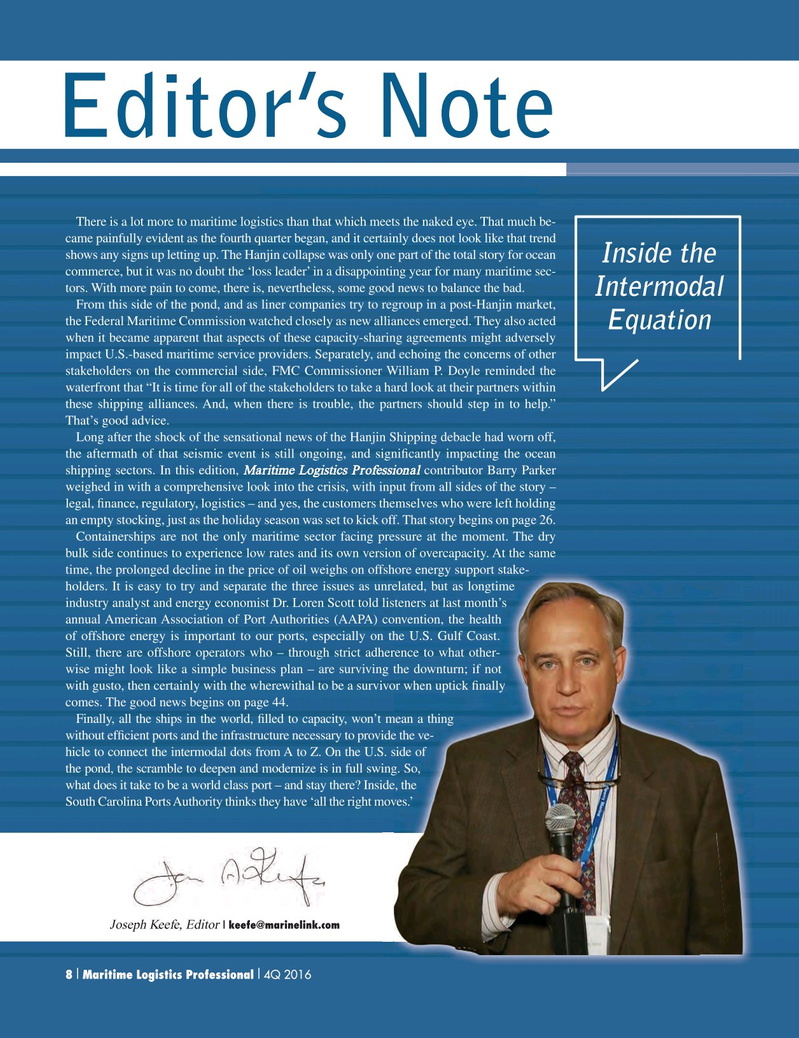
Page 8: of Maritime Logistics Professional Magazine (Q4 2016)
Workboats
Read this page in Pdf, Flash or Html5 edition of Q4 2016 Maritime Logistics Professional Magazine
Editor’s Note
There is a lot more to maritime logistics than that which meets the naked eye. That much be- came painfully evident as the fourth quarter began, and it certainly does not look like that trend shows any signs up letting up. The Hanjin collapse was only one part of the total story for ocean
Inside the commerce, but it was no doubt the ‘loss leader’ in a disappointing year for many maritime sec- tors. With more pain to come, there is, nevertheless, some good news to balance the bad.
Intermodal
From this side of the pond, and as liner companies try to regroup in a post-Hanjin market, the Federal Maritime Commission watched closely as new alliances emerged. They also acted
Equation when it became apparent that aspects of these capacity-sharing agreements might adversely impact U.S.-based maritime service providers. Separately, and echoing the concerns of other stakeholders on the commercial side, FMC Commissioner William P. Doyle reminded the waterfront that “It is time for all of the stakeholders to take a hard look at their partners within these shipping alliances. And, when there is trouble, the partners should step in to help.”
That’s good advice.
Long after the shock of the sensational news of the Hanjin Shipping debacle had worn off, the aftermath of that seismic event is still ongoing, and signi? cantly impacting the ocean shipping sectors. In this edition, Maritime Logistics Professional contributor Barry Parker weighed in with a comprehensive look into the crisis, with input from all sides of the story – legal, ? nance, regulatory, logistics – and yes, the customers themselves who were left holding an empty stocking, just as the holiday season was set to kick off. That story begins on page 26.
Containerships are not the only maritime sector facing pressure at the moment. The dry bulk side continues to experience low rates and its own version of overcapacity. At the same time, the prolonged decline in the price of oil weighs on offshore energy support stake-fshore energy support stake- holders. It is easy to try and separate the three issues as unrelated, but as longtime nrelated, but as longtime elated, but as longtime lis steners at last month’s industry analyst and energy economist Dr. Loren Scott told listeners at last month’s annual American Association of Port Authorities (AAPA) convention, the health co onvention, the health n th h h U S G lf C of offshore energy is important to our ports, especially on the U.S. Gulf Coast. he U.S. Gulf Coast.
Still, there are offshore operators who – through strict adherence to what other-her rence to what other- wise might look like a simple business plan – are surviving the downturn; if not g t the downturn; if not vo or when uptick ? nally with gusto, then certainly with the wherewithal to be a survivor when uptick ? nally comes. The good news begins on page 44.
Finally, all the ships in the world, ? lled to capacity, won’t mean a thing m mean a thing without ef? cient ports and the infrastructure necessary to provide the ve-ide e the ve- hicle to connect the intermodal dots from A to Z. On the U.S. side of S. s side of the pond, the scramble to deepen and modernize is in full swing. So, ing g. So, what does it take to be a world class port – and stay there? Inside, the de e, the
South Carolina Ports Authority thinks they have ‘all the right moves.’mov ves.’
Joseph Keefe, Editor | [email protected] 8 Maritime Logistics Professional 4Q 2016I I 1-17 Q4 MP2016.indd 8 11/10/2016 2:28:46 PM

 7
7

 9
9
